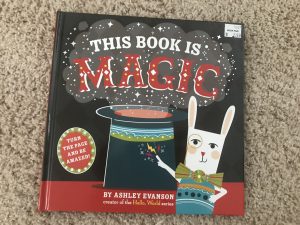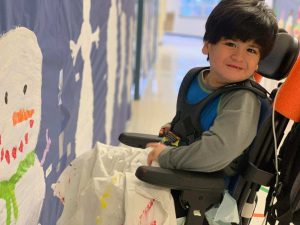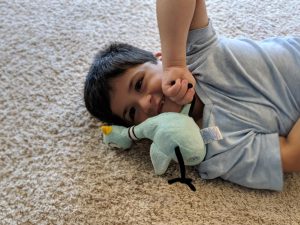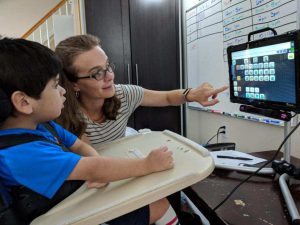 Joey and I recently enjoyed a few weeks of reading This Book is Magic by Ashley Evanson. Much like the books Push Here by Herve Tullet, This Book is Magic encourages the reader to fully interact with the book – tapping the page, waving or twirling fingers in the air, and saying magic words in order to make magic be revealed when you turn the page.
Joey and I recently enjoyed a few weeks of reading This Book is Magic by Ashley Evanson. Much like the books Push Here by Herve Tullet, This Book is Magic encourages the reader to fully interact with the book – tapping the page, waving or twirling fingers in the air, and saying magic words in order to make magic be revealed when you turn the page.
“Wiggle your fingers and say bravo!”
“Wave your magic finger and say Bippity Boppity Big”
Throughout the book the reader is able to turn a frog into a prince, make books large, cause a boat to disappear, and interact with a lion.

 I have a love/hate relationship with knock knock jokes. For the love side, they are fun, silly, occasionally clever, and a great way to joke around with young kids. I’ve even introduced them as replacement behaviors when children want to engage with a peer but don’t know how. “Want to hear a joke?” is much better than “Our teacher is stupid and ugly” or simply pushing a peer to get their attention. So I know my fair share of knock knock jokes. On the hate side, once a child tends to learn a good knock knock joke they tend to use it repeatedly, expecting you to find it funny each and every time. And then there is that developmental window before children understand why the knock knock jokes are actually funny to other people. They create their own – “knock knock, who’s there? Cow? Cow Who? Cow cat dog dance with meeeee and the CHICKEN!” And you have to laugh even though it makes no sense.
I have a love/hate relationship with knock knock jokes. For the love side, they are fun, silly, occasionally clever, and a great way to joke around with young kids. I’ve even introduced them as replacement behaviors when children want to engage with a peer but don’t know how. “Want to hear a joke?” is much better than “Our teacher is stupid and ugly” or simply pushing a peer to get their attention. So I know my fair share of knock knock jokes. On the hate side, once a child tends to learn a good knock knock joke they tend to use it repeatedly, expecting you to find it funny each and every time. And then there is that developmental window before children understand why the knock knock jokes are actually funny to other people. They create their own – “knock knock, who’s there? Cow? Cow Who? Cow cat dog dance with meeeee and the CHICKEN!” And you have to laugh even though it makes no sense. When we talk about reciprocal communication, we think about having a conversation when one person speaks, someone replies, then the initial speaker follows up.
When we talk about reciprocal communication, we think about having a conversation when one person speaks, someone replies, then the initial speaker follows up.  “Seagull being fixed” Joey said to me as I was putting away the materials from one activity and transitioning us to the next. “Really?” I asked, “a seagull? What happened?”
“Seagull being fixed” Joey said to me as I was putting away the materials from one activity and transitioning us to the next. “Really?” I asked, “a seagull? What happened?” Last week
Last week 
